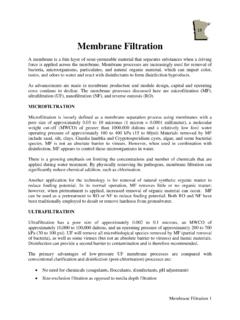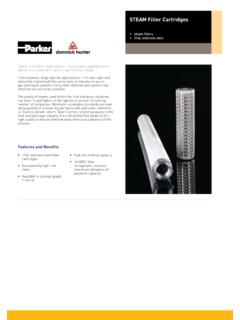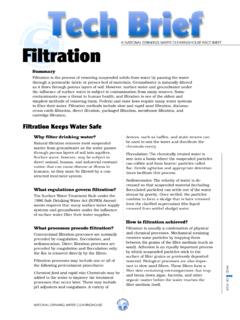Transcription of BRINE DISPOSAL FROM LAND BASED MEMBRANE …
1 BRINE DISPOSAL FROM land BASED MEMBRANE desalination plants : A critical assessment By Julius Glater and Yoram Cohen Polymer and Separations Research Laboratory University of California, Los Angeles DRAFT Prepared for the Metropolitan Water District of Southern California CEC PIER II Contract No. 400-00-013, desalination Research and Innovation Partnership; Improving Energy Usage, Water Supply Reliability, and Water Quality Using Advanced Water Treatment Processes; Subtask Evaluate Various BRINE Minimization Technologies July 24, 2003 BRINE DISPOSAL FROM land BASED MEMBRANE desalination plants A critical assessment by Julius Glater and Yoram Cohen Polymer and Separations Research Laboratory University of California, Los Angeles INTRODUCTION The earliest applications of desalination technology date back to the use of boiler condensate on early steam-ships.
2 Installation of large-scale land - BASED desalination facilities began in the Middle East shortly after the end of WW II. These saline water evaporators were sited along the Persian Gulf and other costal locations. An especially large increase in desalination capacity began in the late 1960 s as a result of the proven reliability of reverse osmosis MEMBRANE desalination systems. In general, BRINE DISPOSAL at costal sites has met with few problems provided that careful consideration was given to sitting the outfall conduit. Following more than three decades of continuing expansion of sea water desalination capacity at costal sites, considerable interest has now shifted to reclamation and reuse of inland water sources.
3 Worldwide desalination capacity has more than doubled in the past two years according to a recent article by Wangnick [1] and this trend is expected to continue in the near future. Of special concern is the ongoing increase in salinity of natural water resources in the South Western United States and especially in Southern California, which depends, to a large extent, on the Colorado River and other water resources, with salinity levels in excess of the U. S. Public Health Service standard [2]. As a result of shortage 1of good quality ground water and surface water, several states including Florida, Texas, New Mexico, Utah and California, have conducted field studies and/or implemented MEMBRANE desalination technology to various degrees.
4 In the United States, it has now become economically feasible to renovate various natural water sources by MEMBRANE desalination processes. Recent development of high performance low pressure reverse osmosis membranes has resulted in a significant reduction of energy costs. At this time, brackish waters in the salinity range of 2,000 5,000 mg/L can be brought up to drinking water quality at a cost of approximately $ - $ per 1,000 gallons compared with sea water desalination costs in the range of $ - $ per 1,000 gallons [3]. In addition, desalination at the salinity range of most surface and ground waters under consideration can be performed at relatively low trans- MEMBRANE pressures, in the range of 200 300 psi. Inland desalination plant sitting, presents greater challenges to the designer than building a similar facility at a costal location.
5 The issue of greatest concern involves development of cost effective BRINE DISPOSAL systems, which conform to regional and federal environmental constraints. Such systems often involve acquisition of land and pipeline construction for delivery of waste streams from a large desalination facility. Even at high product water recovery and establishment of BRINE minimization technology, volumes of highly concentrated plant discharge streams can be very large. 2 Requirements for BRINE minimization are clearly illustrated in specifications for a 300 million gallons per day (MGD) MEMBRANE desalination plant proposed by the Metropolitan Water District of Southern California (MWD). This plant, designed for 85% recovery, would produce a BRINE discharge stream of 45 MGD [4].
6 Systems for BRINE minimization, presently under study, however, could significantly reduce the plant discharge volume. Operating according to design specifications, such a system would increase product water recovery to , thereby reducing the BRINE stream to about MGD. The overall salt concentration ratio (CF=Cc/Cf , where Cc and Cf are retentate and feed concentrations, respectively) can be calculated at each stage of the desalination process using the following relationship: [11(11wswCFRRR = ]) (1) where Rs is the fractional salt rejection (Rs=1-Cp/Cf) and Rw is the fractional product water recovery (Rw=Qp/Qf, where Qp and Qf are the permeate and feed flow rates, respectively).
7 As an example, assuming a 700 mg/L TDS level for Colorado River (CR) water, the BRINE TDS, following a first desalination stage at 99% rejection and 85% recovery, would rise to 4,627 mg/L. Following treatment of the BRINE stream to achieve a total recovery of say (at the same rejection level), TDS levels would again increase to 45,850 mg/L. This calculated value may exceed the solubility of some inorganic salts which are likely to precipitate. It is expected that such a discharge would contain a suspension of various crystalline substances, especially if an enhanced precipitation process is used in the BRINE minimization system. As a result, handling such a concentrated BRINE stream would indeed present several challenges.
8 The major strategies for BRINE DISPOSAL at inland sites are limited to three general categories; 1) Deep Well Injection 2) Evaporation Ponds and 3) Solar Ponds. Several other systems for utilization of waste BRINE have been proposed, which include, among others, irrigation of salt tolerant plants (halophytic crops) and BRINE 3shrimp harvesting [5]. Such approaches have been limited and are certainly not applicable to very large volumes of wastewater. Recovery of inorganic salts with potential commercial value has also been suggested [6], but construction of chemical separation facilities would indeed result in a costly venture. It is important to recognize the prime mission of any desalination facility, which is to upgrade water quality - not to market by-products.
9 To date, proposed by-product recovery systems have not demonstrated economical viability and it seems likely that the cost of by-product recovery would far exceed the cost of the principal product water. A system known as zero discharge [7] has also been used in certain situations where waste BRINE streams are relatively small and available land is limited. This technology has generally been applied to wastewater DISPOSAL from power plants , oil refineries and certain mining operations. The final stage of such a system involves thermal evaporation, subsequently providing a solid residue. Energy requirements are large and overall economics unfavorable for handling large BRINE volumes. 4A discussion of the wide variety of the above alternative schemes for BRINE management is not relevant for the large desalination facility, proposed by MWD.
10 As a result, this report will focus on a review of technological features presented in current literature on each of the three major categories for handling the anticipated large volumes of waste BRINE from a 300 MGD desalination facility. An in depth summary of BRINE DISPOSAL methods by Mickley [8], presents detailed documentation of the impact of regulatory and environmental considerations on the development of this technology. Mathematical models for estimation of concentrate DISPOSAL costs are also included in this comprehensive work. An overall review of the current state of the art in BRINE DISPOSAL has been presented at a recent workshop sponsored by the American MEMBRANE Technology Association [9]. DEEPWELL INJECTION Deep well injection is presently applied worldwide for DISPOSAL of industrial, municipal and liquid hazardous wastes [10].





